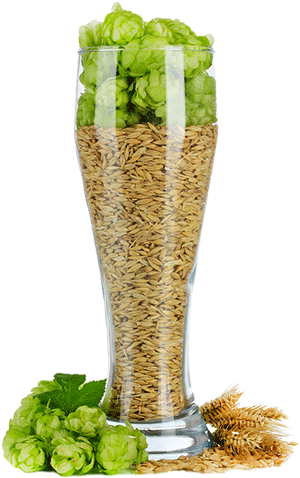This is a very basic malt guide, which can give some ideas how to create your own malt profile. There are so many exciting malts out there, but for this guide I just chose some of my most used malts.
but for this guide I just chose some of my most used malts.
Malt can roughly bee divided into 4 groups: Base Malt, Caramel Malt, Chocolate/Roasted Malt and Special Malt. The base malt typically accounts for up to 75-100% of the total amount of malt.
Base malts
Pilsner malt 2 - 3 ebc. / 1 - 2 srm. / 1 oL (Can make up 100% of the recipe)x
- Pilsner malt is the lightest malt in color.
- Used as a base malt in all types of beer.
Vienna malt 3 - 8 ebc. / 2 - 5 srm. / 1 - 4 oL (Can make up 100% of the recipe)
- The malt is a little darker than lager beer. Gives the beer a golden color, but also body and fullness, just as it is added aromas of caramel and toffee.
- Used in all types of beer and Vienna lager.
Pale (ale) malt 7 - 9 ebc. / 5 - 7 srm. / 3 - 4 oL(Can make up 100% of the recipe)
- The malt is a bit darker than pilsner malt. Can be used as a base malt.
- Used in Pale ale beers and most English beers.
Munich malt 15 - 25 ebc. / 7 - 12 srm. / 7 - 10 oL (Can make up 90% of the recipe)
- The malt is a bit darker than Viennese malt. Adds a golden, orange color, which gives the beer a malty taste.
- Used for Pale ale, amber, brown, strong and dark beers, bock.
Caramel Malt
Cara-pils 5.0 ebc. (Can make up 5% of the recipe)
- The lightest caramel malt. Gives not much caramel taste, but good body and foaming.
- Used in Pilsner and bock.
Carahell 20 - 30 ebc. (Can make up 30% of the recipe)
- Used for light beers to achieve more malt extract and fullness. Gives the beer a sweet malt taste and enhances foaming and aroma.
- Used in wheat beers, Octoberfest type beer, pale ale, Maibock.
Carared 40 - 50 ebc. (Can make up 25% of the recipe)
- Gives the beer a reddish color, improves foaming and pronounced malt aroma.
- Used in Scottish ale, red ale, brown ale.
Cara-amber 60 ebc. (Can make up 20% of the recipe)
- Gives a beautiful red color, good malt aroma and foaming, as well as biscuit taste.
- Used in Brown ale and red lager.
Cara-Rye 90 ebc. (Can make up 15% of the recipe)
- Gives a nice dark color and taste of rye.
- Used in Colored beers.
Cara-Munich 100 ebc. (Can make up 10% of the recipe)
- Gives fullness, residual sugar and caramel-like taste.
- Used in Abbey ale, October party beer, porter, stout and brown ale.
Cara Gold 120 ebc. (Can make up 20% of the recipe)
- Contributes with a caramel-sweet aroma and toffee flavor. Gives the beer a brownish color.
- Used in Brown, colored beers.
Cara-Crystal 120 ebc. (Can make up 10% of the recipe)
- Gives good fullness, body and color.
- Used in All dark beers.
Cara-wheat 120 ebc. (Can make up 15% of the recipe)
- Gives a biscuit-like taste.
- Used in Dark wheat beer and dark ales.
Chocolate and Roasted Malt
Smoked malt 3-4 ebc. / 2-3 srm. / 1 - 2 oL (Can make up 5% of the recipe)
- Adds a smoky, spicy aroma and taste to the beer.
- Used for Scottish ale, porter, smoked beer, specialty beer.
Melano Light 40 - 80 ebc. / 20 - 40 srm. / 15 - 30 oL (Can make up 20% of the recipe)
- Contributes to the fullness of the beer and improves the stability of the beer taste and highlights the red color in the beer.
- Used for Amber and dark beers, Scottish types and reddish beers, such as Scottish ale, amber ale, red ale and Irish ale.
Abbey 45 ebc. / 20 srm / 15 oL(Can make up 10% of the recipe)
- More toasted form of pale malt. Gives a stronger taste in the form of bread, nuts and fruit. Gives a bitter taste.
- Used for Pale ale, brown porter and specialty beers.
Biscuitmalt 50 ebc. / 25 srm / 19 oL(Can make up 15% of the recipe)
- Gives a pronounced "roasted" taste to the beer. Adds a bread and biscuit-like aroma and taste. Used to give a toasted taste and aroma.
- Used in Special beer, English ale, brown ale and porter.
Aromamalt 100 ebc. / 50 srm / 37 oL(Can make up 20% of the recipe)
- Gives a malty aroma and taste to amber and dark lager beers. Adds a soft bitterness.
- Used in very aromatic beers.
Crystalmalt 150 ebc. / 76 srm / 56 oL (Can make up 20% of the recipe)
- Adds a rich malt flavor and aroma to amber beer and dark lager beer. Gives a softer bitterness.
- Used in Aromatic and colored beers. Perfect in any beer where a distinctive malt profile is needed. Good for Belgian ales and bock.
Special B malt 300 ebc. (Can make up 10% of the recipe)
- Gives a unique taste and aroma. Gives a color and raisin-like taste. Adds a rich malty taste with a hint of nuts.
- Can replace chocolate and black malt if no bitterness is desired Used to achieve a deep red and dark brown / black color and fuller body.
- Used in Abbey ale, double, porter, brown ale, doppelbock.
Coffee malt 500 ebc. (Can make up 5% of the recipe)
- Gives the beer a mild and nutty and coffee-like taste and aroma. Gives a complex taste in dark ale and also supports the color of the beer.
- Used in Stout, gates and some brown ales.
Dehusked (peeled) chocolate 800 ebc. (Can make up 5% of the recipe)
- Gives a milder taste as the shells are taken from the malt.
- Used in Stout, brown ale, Scottish ale.
Chocolate malt 900 ebc. (Can make up 7% of the recipe)
- The malt is a very roasted malt with a deep brown color. Gives a nutty and toasted flavor. Is less bitter than black malt.
- Used in Brown, strong, darker and black beers such as porter, stout and brown ale.
Dehusked (peeled) chocolate 1200 ebc. (Can make up 5% of the recipe)
- Gives a milder taste as the shells are taken from the malt.
- Used in Stout, gates.
Black malt 1500 ebc. (Can make up 3 - 6% of the recipe)
- Emphasizes the aroma by giving a tighter taste compared to other malts. Adds a slightly burnt or smoky taste.
- Used in Stout and gates.
Wheat malt
Wheat malt 3 - 5 ebc. (Can make up 30% of the recipe)
- Emphasizes the special taste of wheat beer. Can be used in other types of beer, which make the beer feel fuller and improve the stability of the beer foam.
- Used in Wheat beer, wit, light beer, beer with low or no alcohol.
Munich wheat malt 15 ebc. (Can make up 30% of the recipe)
- Not very dark in color, but richer in flavor than standard wheat malt. Gives a lively beer with a smaller body with a typical ale-aroma and makes the foam durable.
- Used in Dark wheat beer types, weizenbock, stout.
Chocolate Wheat 1100 ebc. (Can make up 5% of the recipe)
- Gives intense aroma to all dark beers.
- Used in Dark wheat, porter, stout.
Cereals - flakes
Flaked barley (barley flakes) 2 - 5 ebc. (Can make up 10% of the recipe)
- Gives a grainy taste and nice foam.
- Used in Ale and stout.
Flaked corn (corn flakes) 1 - 3 ebc. (Can make up 20% of the recipe)
- Gives higher alcohol content and a taste of corn.
- Used in English ales and American lager beers.
Flaked oats (oatmeal flakes) 3 - 6 ebc. (Can make up 10% of the recipe)
- Gives a creamy beer.
- Used in Belgian wheat beer and stout.
Flaked wheat 2 - 5 ebc. (Can make up 50% of the recipe)
- Used to achieve stable foam Helps to give a softer and rounder beer.
- Used in Belgian wheat beer and witbier.
Flaked rye 2 - 7 ebc. (Can make up 20% of the recipe)
- Works foam stabilizer. Gives a distinct rye bread-like taste.
- Used in rye beer.
Flaked rice (rice) 2 ebc.
- Does not add flavor, but helps to raise the alcohol percentage, and adds a dryness to the beer that highlights the hops.
Other Malt Types
Roasted barley 1200 ebc. (Can make up 10% of the recipe)
- Barley that is not malted, which gives a round and dry taste.
- Used in Stout, porter and Scottish ale.
Acid malt 3 - 7 ebc. (Can make up 5% of the recipe)
- Provides good mash condition. Suitable for light beers as it makes the beer lighter.
- Used in Pilsner, wheat beer, Belgian ale and stout.
Dextrin malt 20 - 30 ebc. (Can make up 40% of the recipe)
- The sugar in the malt cannot be converted into alcohol by the yeast. Gives lager beer more fullness.
- Used in Pilsner, Bock and lager beer.
Amber malt 50 ebc. (Can make up 10% of the recipe)
- Gives the beer an amber color and a biscuit-like taste.
- Used in Porter, brown ale, mild ale, old ale and amber ale.
Melanoidin malt 70 ebc. (Can make up 20% of the recipe)
- Stabilizes the taste of the finished beer.
- Used in Dark beers.
Source: http://www.castlemalting.com/
